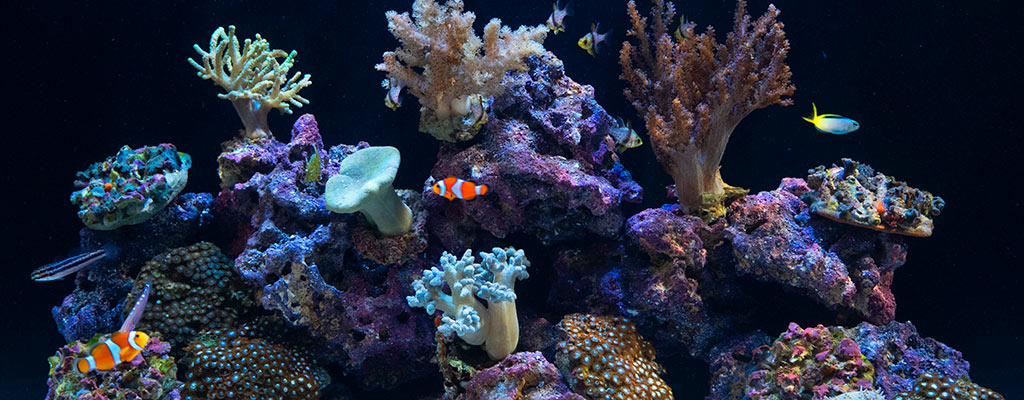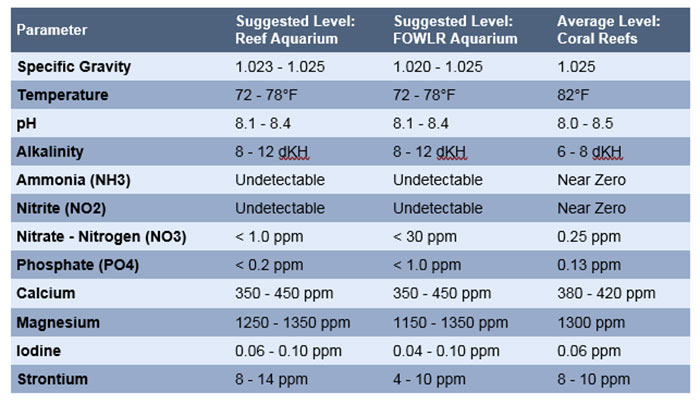|
Reef Aquarium Basics

As complicated as reef keeping can get, it all goes back to basics. The essential requirement to all life is water. A healthy and thriving reef aquarium begins with the purest form of water possible.
Two of the purest forms of water are distilled water and reverse osmosis (R/O) water. Distillation is the most effective form of water purification. Distillation works by boiling
water. The evaporated water which leaves behind contaminants is collected and bottled. Distilled water can be purchased, but that requires a lot of trips to the store, especially if you have a larger aquarium. Also, a distillation
unit is not offered commercially for residential applications.
R/O water is a more practical option for residential use. R/O filtration systems use pressure to force water through a semi-permeable membrane which filters out impurities such
as dissolved salts, organics, bacteria, and metals such as copper and lead. The membrane filter cartridges will need to be replaced periodically, as the pores in the membranes will start to clog due to the impurities being filtered
out. Longevity of the membrane cartridges depends on your water quality. The cleaner the water, the longer your membranes will last. The more impurities your water has, the shorter the life of the membrane.
If neither distilled water or R/O water is an option, water conditioners are available to make tap water suitable for reef aquarium use.
As mentioned previously, distilled water and R/O water are preferred. Any advanced reef keeper will attest to this statement. If conditioned tap water is your only option, you may be limited to fewer types of hardy corals and invertebrates.
Once you have your purest form of water, you need to turn it into sea water by adding salt and minerals to it. I know, sounds counterintuitive, right? However, for saltwater fish, corals, and invertebrates to thrive, you need
to replicate the natural sea water (NSW) from their aquatic environments. This is made possible with commercially-available salt mixes and reef supplements. Aquarium
salt mixes contain minerals and vital elements that convert fresh water to saltwater when mixed. Proper salinity, or amount of salt in the water, is critical to the survival
of your reef aquarium inhabitants. Too little or too much salt will harm or even kill the aquarium inhabitants. Whether it's corals, invertebrates, or fish, the desired salinity for a marine aquarium is 35 ppt (parts per
thousand).
Salinity is measured with the use of instruments such as a Hydrometer or Refractometer. Hydrometers are an effective and less expensive option for measuring salinity.
Refractometers are a more precise way to measure salinity, but also more expensive.
Vital elements were previously mentioned. So, what are vital elements? Vital elements are chemical elements required by corals, plants, fish, and other forms of aquatic life. Chemical elements extremely vital to corals,
include calcium, carbonate, strontium,
and magnesium.
Also critical to marine aquariums are proper pH and alkalinity. pH stands for potential hydrogen, and is measured on a logarithmic scale. The pH scale is numbered 0 to 14. The low end of the scale is acid and the
high end of the scale is alkaline. In the middle of the scale you have 7, which is considered neutral. NSW has a pH between 8.1 and 8.4, which is alkaline.
To give you a contrasting example of pH, let’s consider two different water sources:
Water from certain areas of the Amazon River has a low pH and is considered acidic. This occurs because these areas of the Amazon River are full of tree stumps, branches, and leaf litter. As these organic materials
break down they release tannins. Tannins are dark in color, and are one of the reasons for the Amazon River’s brown color, and acidity. Since acids lower pH, the typical pH in these areas of the Amazon River
is anywhere from 4.5 to 6.5. With that said, any fish from this region would need to be kept at a lower pH in the aquarium.
On the flip side, take water from the Great Barrier Reef. The pH is 8.1 to 8.4 due to the salt and minerals in the water, so this measures more alkaline on the pH scale.
Another important water parameter is temperature. Proper water temperature for a reef aquarium should be around 76-78ºF. Aquarium temperature is maintained through the use of an aquarium heater.
In warm locations, an aquarium chiller can also be used to keep the aquarium from getting too warm.
Marine Parameters
The following chart is a general guideline of acceptable water parameter ranges for different types of tropical marine aquariums. Some types of displays, such as Fish-Only-With-Live-Rock (FOWLR)
aquariums, have a broader range of parameters than a reef aquarium. This is due to the delicate nature of certain corals and invertebrates requiring specific or a narrower range of water parameters
that are commonly maintained in a reef aquarium. For reference, we have also provided the average water conditions measured on tropical coral reefs across the world.

Maintain Water Purity
The second most essential requirement to any aquarium is filtration. Filters and filtration methods differ depending on the application –
freshwater, saltwater or reef aquarium. There are a myriad of filters available for the hobbyist to purchase. A few examples of popular aquarium filters include canister filters,
hang-on-the-back filters, and wet/dry filters with sumps.
Filtration helps maintain and keep your aquarium water at optimal conditions. There are three different types of filtration that the aquarium filter can perform:
Mechanical Filtration:
Most filters have some type of mechanical filtration media such as a sponge, foam, or pad that the water flows through. Mechanical filtration trap and removes particulates, debris, and
organic matter from the aquarium water column.
Biological Filtration:
As a new aquarium matures it starts to develop a population of beneficial nitrifying bacteria that breaks down toxic nitrogenous waste materials including ammonia. Nitrifying bacteria
play an important role in providing biological filtration to naturally break down ammonia to nitrites, and nitrites into less harmful nitrates.
Chemical Filtration:
Some filters have additional space or compartments where chemical filter media like activated carbon can be added. Activated carbon is a water purifier that absorbs dissolved
chemicals and organics that can contaminate water.
Monitoring your aquarium's water parameters is also essential, so test kits are beneficial to all aquarists, including the beginner, intermediate, and advanced. There are
several different specific test kits available for freshwater or saltwater aquariums.
Lighting is another requirement for the reefaquarium. Not only does lighting aid in enhancing the overall visual aesthetic of an aquarium, it is also necessary for the
growth of plants and corals. There are light fixtures made specifically for general viewing or coral growth so be sure to select lights designated for reef aquarium
use to provide your corals the light they need to thrive.
|